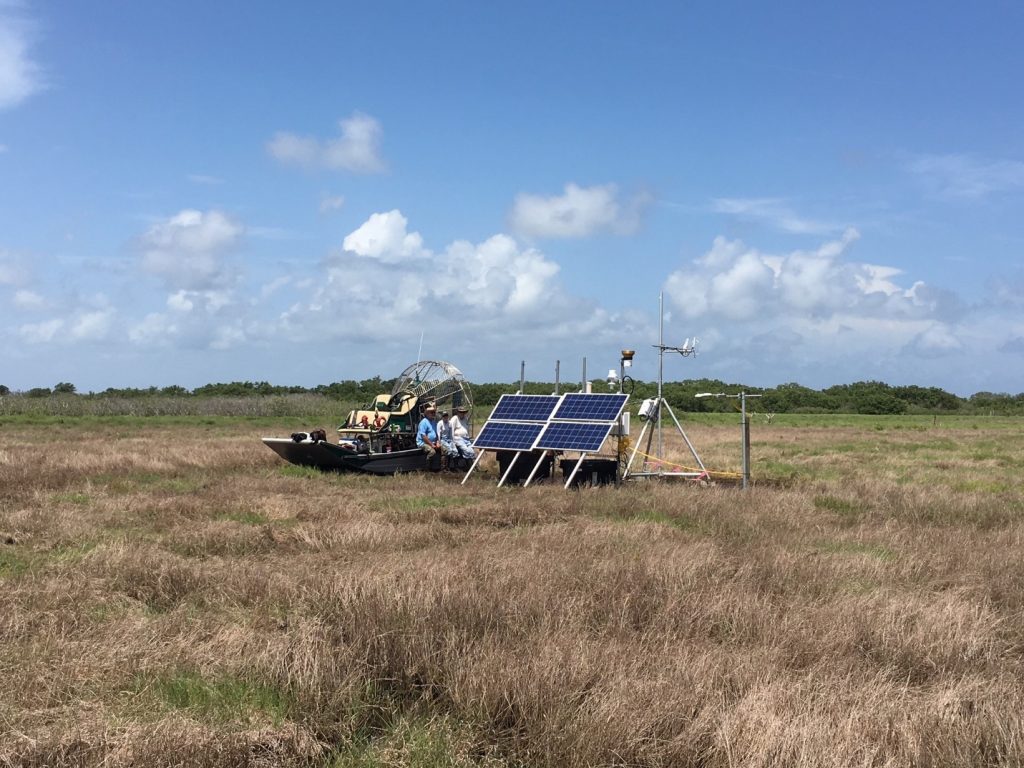
US-KS3 an east central Florida salt marsh (Distichlis spicata L.) is a site in which black mangrove (Avicenna germinans L.) is encroaching with the eventual expectation that the graminoid marsh will be converted to mangrove forest? Mangrove can be seen in the center right of the photo and in the center left background.
The Science:
The encroachment of woody species such as mangrove invading coastal marshes is expected to change the carbon storage in the soils and biomass as well as exchanges with the atmosphere. Doughty, et. al. (2015) demonstrated an increase of carbon stock at a salt marsh located at Merritt Island national Wildlife refuge in Florida. In one of the same area marshes, Steinmueller, et. al. (2020; 2019) have evaluated soil and carbon dynamics in an east central Florida coastal salt marsh impacted by both sea level rise and subsequent vegetation encroachment. The full extent of how coastal marshes will adapt to these changes is an ongoing question for coastal marsh management and understanding ecosystem dynamics related to climate change.
Thanks to the AmeriFlux Rapid Response System Program an eddy flux tower was installed and operated at the site for two years (US-KS3). The flux tower footprint included areas dominated by Distichlis, areas with minimal mangrove shrub invasion, and an area dominated by mangrove on the northeastern side of the reach. More than a year of data from this site has been published on the AmeriFlux web site as US-KS3 (https://ameriflux.lbl.gov/sites/siteinfo/US-KS3), which will benefit researchers trying to understand the carbon exchange dynamics of coastal systems being altered by vegetative encroachment and sea level rise.
References:
Doughty, C.L., Langley, J.A., Walker, W.S., Feller, I.C., Schaub, R., Chapman, S.K. 2015. Mangrove range expansion increases coastal wetland carbon storage. Estuaries and Coast. https://doi.org/10.1007/s12237-015-9993-8
Steinmuller, H.E., Foster, T.E., Boudreau, P., Hinkle, C.R., and Chambers, L. 2020. Characterization of herbaceous encroachment on soil biogeochemical cycling within a coastal marsh. Science of the Total Environment. https://doi.org/10.11016/j.scitotenv.2020.139532.
Steinmuller, H.E., Foster, T.E., Boudreau, P., Hinkle, C.R., Chambers, L.G., 2019. Tipping Points in the Mangrove March: Characterization of Biogeochemical Cycling Along the Mangrove–Salt Marsh Ecotone. Ecosystems. https://doi.org/10.1007/s10021-019-00411-8
Contact:
Ross Hinkle, Professor Emeritus, University of Central Florida, rhinkle@ucf.edu

No Comments
Be the first to start a conversation